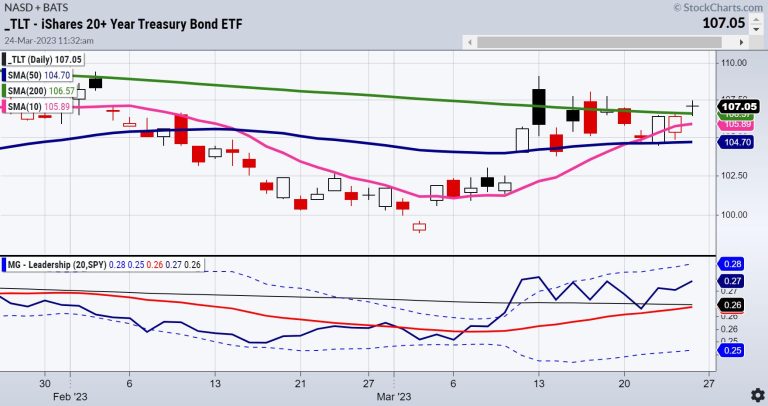One of the best questions I got asked this week was “How can you be long gold and long semiconductors at the same time?” And I have a simple answer for that.
We love to take a position based on the macro, which is why gold has been so compelling. Nonetheless, the algorithms have also added up for semiconductors. Plus, the algos finally followed the macro analysis and told us to buy gold. So, it’s always a combination of art and math, with risk parameters the constant feature for both.
The market is in a very interesting spot right now. 3 ratios are telling us 3 different stories. The first ratio is the one between long bonds (TLT) and the S&P 500 (SPY). With long bonds outperforming the SPY, the calls for recession are all around. However, the softening of the yields also signals more QE and emboldens the growth stocks. And this is in the face of another rate hike by the Fed this past week.
Wait, there’s more.
The next ratio is the one between silver and gold.
Silver is outperforming gold, which is inflationary. Since it also means that silver, a more industrial metal, is good for the economy, it implies that there is not a recession on the horizon. Meanwhile, if silver continues to outperform, it also means demand for the metal is rising while supply may not be (hence the ratio). That means inflationary.
Add the TLT:SPY and the SLV:GLD ratios together, and you can see why this is such a hard macro environment to figure out. And why we love the math.
So far, recession and inflation at the same time, still means stagflation.
And then there is the dollar.
Although, historically, the dollar rising and gold rising have been known to happen simultaneously, we are looking at the dollar to the Euro for clues. The dollar typically goes up when interest rates do. But this past week, the dollar closed lower WoW.
Is the dollar sniffing a pause by the Fed? A currency crisis? An anticlimactic end to the banking issues with government rescues?
If any of those scenarios come to pass, it will continue to be great for semiconductors. And can still be bullish for gold and inflation. At 1.08, the dollar is nearly at par with the Euro.
Hence, this coming week, we will continue to watch what the bonds (closed unchanged WoW) do versus the SPY (closed higher WoW). We will see if silver’s performance (closed higher WoW) remains dominant over gold’s (closed unchanged WoW) performance. And, with news (on the backburner) about Iran, Russia, and China still a thing, we will watch the dollar and how it performs against the Euro. Any major continuation or shift in these 3 key ratios, should help us see not only the macro (more of an art) but also the sector strength (more about science).
One thing nobody can deny–the resiliency of the indices in the face of the persistent trading range.
For more detailed trading information about our blended models, tools and trader education courses, contact Rob Quinn, our Chief Strategy Consultant, to learn more.
IT’S NOT TOO LATE! Click here if you’d like a complimentary copy of Mish’s 2023 Market Outlook E-Book in your inbox.
“I grew my money tree and so can you!” – Mish Schneider
Get your copy of Plant Your Money Tree: A Guide to Growing Your Wealth and a special bonus here.
Follow Mish on Twitter @marketminute for stock picks and more. Follow Mish on Instagram (mishschneider) for daily morning videos. To see updated media clips, click here.
Mish in the Media
Mish discusses long bonds, Silver to Gold and the Dollar in this appearance on BNN Bloomberg.
Mish sits down with Kristen on Cheddar TV’s closing bell to talk what Gold is saying and more.
Mish and Dave Keller of StockCharts look at longer term charts and discuss action plans on the Thursday, March 17 edition of StockCharts TV’s The Final Bar.
Mish covers current market conditions strengths and weaknesses in this appearance on CMC Markets.
Mish sees opportunity in Vietnam, is trading SPX as a range, and likes semiconductors, as she explains to Dale Pinkert on ForexAnalytix’s F.A.C.E. webinar.
Mish and Nicole discuss specific stock recommendations and Fed expectations on TD Ameritrade.
Coming Up:
March 30th: Your Daily Five, StockCharts TV
March 31st: Festival of Learning Real Vision “Portfolio Doctor”
April 3rd: Webinar with Bob Lang on Options Den
April 4th: The RoShowPod with Rosanna Prestia
April 24-26: Mish at The Money Show in Las Vegas
May 2-5: StockCharts TV Market Outlook
ETF Summary
S&P 500 (SPY): Could be the start of shallower rallies, needs to clear 400 and hold 390.Russell 2000 (IWM): 170 held, so maybe the ratios are implying no recession after all.Dow (DIA): 325 key to clear.Nasdaq (QQQ): Still needs to clear the Feb high. 305 support, 320 resistance.Regional banks (KRE): 35 support, 44 resistance.Semiconductors (SMH): Could be the start of a key reversal w/ 250 support.Transportation (IYT): A weekly close under 219, so watch here for this week.Biotechnology (IBB): Held key support at 125 area.Retail (XRT): Granny held 60; still in the game, especially since that is the January calendar range low.
Mish Schneider
MarketGauge.com
Director of Trading Research and Education

